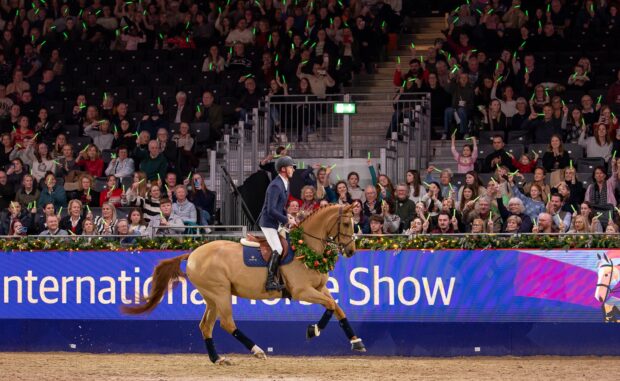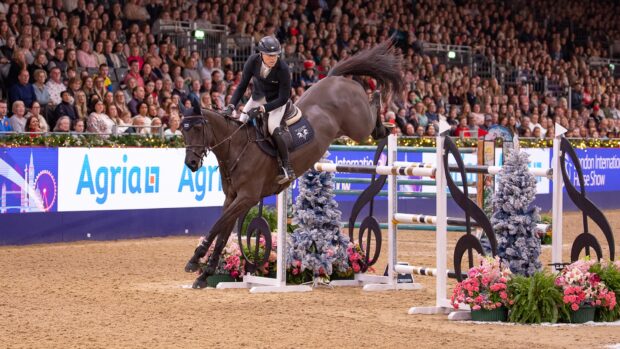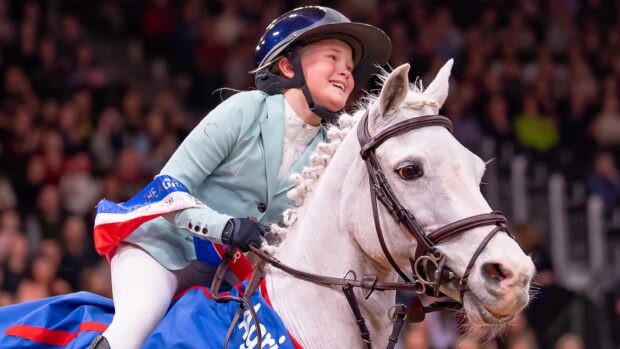A new tool to measure noseband tightness will begin a phased roll-out across FEI events in the first quarter of 2025.
The move has been welcomed by vets, researchers and other leading figures in the equestrian world.
The device is designed to go under the noseband on top of the nasal bone. If it passes through, the noseband is loose enough. If not, the noseband is considered too tight.
The immediate consequences of having a too-tight noseband depend on when in the competition the test is carried out. It could be as simple as loosening the noseband before the horse is allowed to start. In during-competition tests, a too-tight noseband will mean elimination and a yellow warning card.
The shape and size of the device, as well as where on the horse’s face it is used, has been led by research. This research includes a 2015 study on bridle pressure, and also a 2024 study looking at how noseband type and tightness level affect pressure on the horse’s face at trot. Authors of these studies include biomechanical specialists Rachel Murray, Russell MacKechnie-Guire and Jane Williams.
One of the key findings from this research is that tightening the noseband from two fingers to 1.5 fingers “did not significantly increase pressure on the horse’s head and was not within a range at which pain or tissue damage would be expected to occur”. This is noteworthy as it means the new device complies with the science – as its dimensions are equal to 1.5 fingers – and also answers why it is slightly smaller than the International Society of Equitation Science (ISES) taper gauge, which is modelled on two fingers.
Development
An FEI spokesperson told H&H the device has gone through several stages of development, in collaboration with Dr Murray and Hilary Clayton, who are well known for their work in equine health and biomechanics.
“These experts conducted tests in a controlled environment. Afterwards, the FEI moved on to in-competition testing at FEI events across Europe and the USA over a three-month period this year. During the test phase, the prototype underwent slight design adjustments to improve ergonomics for better glide and handling,” said the spokesperson
The final phase involved more than 600 tests on horses at international events across FEI disciplines. The devices will also be available for anyone to buy.
World Horse Welfare chief executive Roly Owers told H&H the charity “is pleased the FEI is introducing a much-needed noseband measuring device”.
“The tightness of nosebands has been a particular point of concern for some time now, and it is so important to make regulations as objective as possible and their implementation consistent,” he said. “What is key now is to ensure that this development helps to tackle current inconsistency in how the rules are applied and that it is shown to remove some of the welfare risk around noseband tightness.”
H&H also spoke to Dr Murray, Dr Williams and Dr MacKechnie-Guire, who all welcomed the move.
They highlighted positives as the fact that it is data-led; that the FEI is now consistently measuring tightness at the front of the head; that it is a standard size – removing variations in sizes of stewards’ fingers, which gives everyone clarity; and it gives competitors a clear “pass or fail”.
Dr Murray explained that pressure under the bridle is a complex picture, made up of many factors, of which nosebands are just one part. She also noted that correctly fitted nosebands have a role to play in stabilising the bridle.
She said that for all those who have welfare of the horse in mind – including riders and the wider sport and public – having a standardised tool that can be used to measure in an easily repeatable way, is a positive.
“Competitors want to know where they stand, and everybody wants the best welfare for the horse, so personally, I think this is a really good thing,” she said.
Positive move
Dr Williams, who is also a former honorary president of ISES, told H&H this is a “really positive move” by the FEI.
She added that, as is always the case in research, there will always be more work to do, but this is a “great first point of call”.
“One of the things we’ve talked about in terms of welfare and how we can improve equine welfare is for the leading organisations in the sector to really take that leadership role and to drive forward practice,” she said, adding that the approach will then trickle down to grassroots.
“The research we’ve done has been done with experienced horses and riders. So there’s more work to also do across the other groups. It’s a very complex situation, it isn’t just about noseband tightness – it’s about the horse, it’s about the rider, it’s about the context. But this is a great starting place.”
Dr Williams also said the ISES taper gauge is a very good tool and although the FEI device is a good “next step”, the ISES gauge should not be discounted as it is still working to promote a positive outcome for the horse.
Dr MacKechnie-Guire added that it is a “really positive step forward for horse welfare and the industry”.
“I think the fact that it is going to be a roll-down across all disciplines is also progress,” he told H&H. “Welfare is welfare across all sectors that involve horses.”
He added: “I really urge all competitors to buy a gauge, check the tightness of their noseband at home and get their horses accustomed to it, so it becomes normal for them.”
British Dressage (BD) has also welcomed the move.
Chief executive officer Jason Brautigam told H&H BD “fully endorses” the work involved and its intention “would be to follow suit and implement this measuring tool at the earliest opportunity”.
“However, we have yet to test this tool in a live environment ourselves and agree how it should be used at BD competitions,” said Mr Brautigam.
“This will need to be integrated into our steward training and then trialled at nominated shows before we roll it out fully, but we welcome this as a positive move.
“Moving the measuring location from the side to the front will work much better from a practical perspective.
“To have a standardised tool that has been developed and informed by the latest scientific research and data is a huge step forward for the sport.”
- To stay up to date with all the breaking news throughout Horse of the Year Show, London International and more, subscribe to the Horse & Hound website
You may also be interested in:

Noseband rules could be changed in all disciplines, plus other proposed revisions

Tight nosebands outlawed by national federation
The new rule is to be introduced from 1 January 2018 following research linking tight nosebands to mouth lesions

Anna Ross: ‘Could judges and technology work together in dressage as in tennis?’

Subscribe to Horse & Hound magazine today – and enjoy unlimited website access all year round




